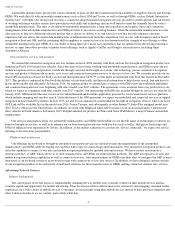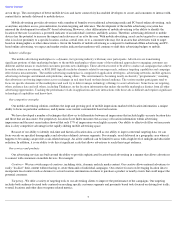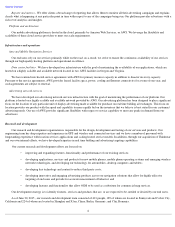TeleNav 2015 Annual Report Download - page 19
Download and view the complete annual report
Please find page 19 of the 2015 TeleNav annual report below. You can navigate through the pages in the report by either clicking on the pages listed below, or by using the keyword search tool below to find specific information within the annual report.
Table of Contents
Fluctuations in our quarterly operating results might lead analysts and investors to change their models for valuing our common stock. As a
result, our stock price could decline rapidly and we could face costly securities class action lawsuits or other unanticipated issues.
We are dependent on Ford for a substantial and increasing portion of our revenue and our business, financial condition and results of
operations will be harmed if our revenue from Ford does not continue to grow or declines.
Ford represented approximately 61% and 46% of our revenue in fiscal 2015 and fiscal 2014 , respectively. We expect that Ford, other
automobile manufacturers and OEMs will account for an increasing portion of our revenue, as our revenue from paid wireless carrier provided
navigation declines. However, our revenue could potentially decline if Ford increases the cost to consumers of our navigation product or reduces
the number of vehicles or the geographies in which vehicles with our product as an option are sold, or its sales of vehicles fall below forecast due
to competition or global macro-economic conditions. Our agreement with Ford expires in December 2017 and also allows either party to
terminate the agreement if the other party is insolvent or materially breaches its obligations and fails to cure such breach. In the event that Ford
does not elect to renew our contract after December 2017, or chooses to renegotiate our contract on less favorable terms, our revenue may
decline and our business operating results and financial condition could be harmed. The agreement may be renewed for successive 12-month
periods if either party provides notice of renewal at least 45 days prior to the expiration of the applicable term, and the other party agrees to such
renewal. We may not successfully increase our revenue from Ford if our products are replaced within vehicles by Ford with our competitors'
products or from price competition from third parties.
For on-board automotive navigation, we recognize revenue as the related customized software is delivered to and accepted by our
customers. In addition we recognize royalties earned from our on-board solutions generally as the software is reproduced for installation in
vehicles. We have limited experience managing, supporting and retaining automobile manufacturers and OEMs as customers and if we are not
able to maintain Ford as a customer our revenue will decline.
We may not be successful in generating material revenue from automotive manufacturers and OEMs other than Ford and our business,
financial condition and results of operations will be harmed if we are unable to diversify our automotive navigation revenue.
Although we have attempted to mitigate our dependence on Ford by establishing relationships with other automobile manufacturers and
OEMs, these relationships may not produce significant revenue if the products are launched in limited models or due to competition from third
parties. In addition, due to the complexities of revenue recognition in accordance with GAAP, when and if we generate revenue we may be
required to recognize certain revenue over extended periods. Revenue recognition could also be impacted by changes in procurement patterns,
shipping terms and title transfer. Furthermore, we may incur significant expense to develop products for automobile manufacturers, such as
under our worldwide connected navigation services agreement with GM, without ever receiving any revenue related to the sale of vehicles with
our navigation services. Our ability to attract automobile manufacturers may also be limited if the OEMs chosen to provide navigation services
have existing relationships with other navigation vendors or provide their own solutions.
Even if we are able to diversify our automotive navigation business through new arrangements, such as our more recently established
relationships with GM and Toyota, customers may not elect to purchase automobile manufacturer and OEM navigation offerings that include our
software and/or services for reasons unrelated to performance of our software or services. If customer purchase rates are less than anticipated, we
may be unable to effectively diversify our automotive navigation revenue and our business, financial condition and results of operations may be
harmed.
Our automotive navigation products are an important part of our effort to expand outside of mobile device navigation to other platforms and
we may not be successful in our efforts to attract and retain automobile manufacturers and OEMs, implement profitable and high quality
products or achieve end customer acceptance of our services and fee model.
In fiscal 2009, we began offering our first brought-in connected automotive navigation products and prior to that time, we had limited
experience in the automotive navigation market. In fiscal 2010, we began offering our first on-board automotive navigation products. Our on-
board solutions may not satisfy automotive manufacturers’ or end customers’ expectations for
13
• potential foreign currency exchange gains and losses associated with expenses and sales denominated in currencies other than the
U.S. dollar;
• general economic, industry and market conditions that impact expenditures for new vehicles, smartphones and mobile location
services in the United States and other countries where we sell our services and products;
• changes in interest rates and our mix of investments, which would impact our return on our investments in cash and marketable
securities;
•
changes in our effective tax rates; and
•
the impact of new accounting pronouncements.
























